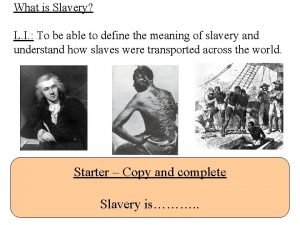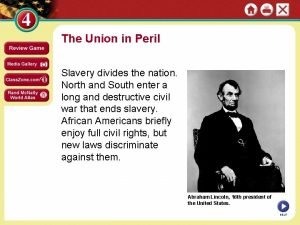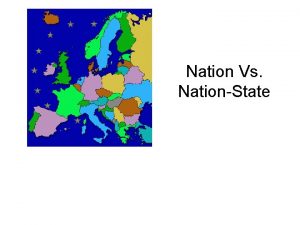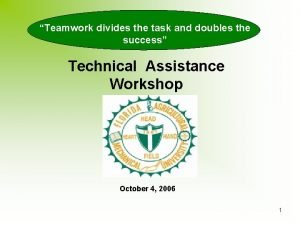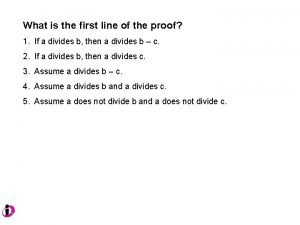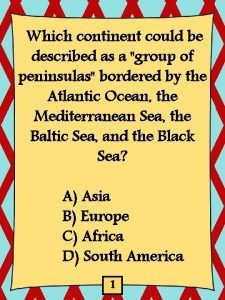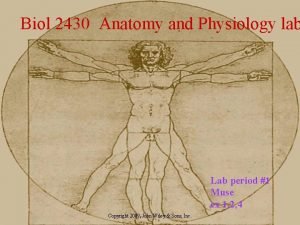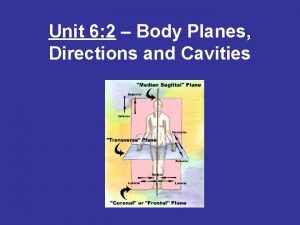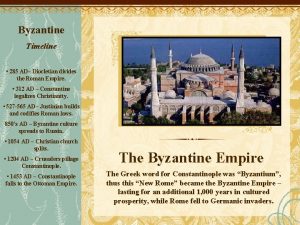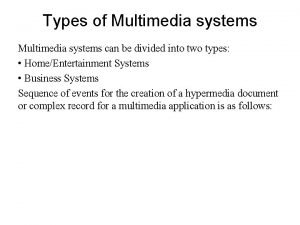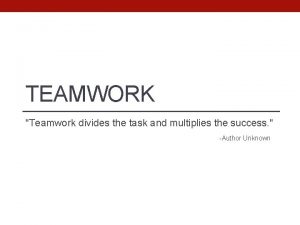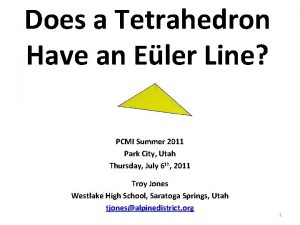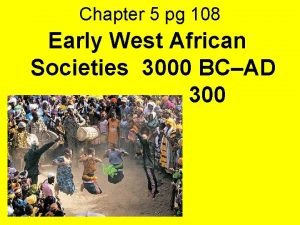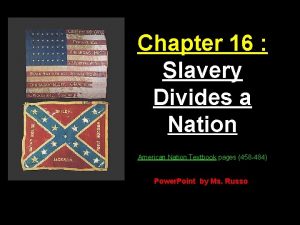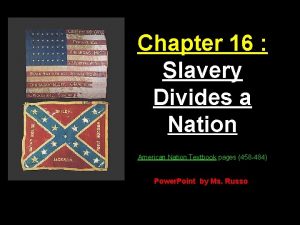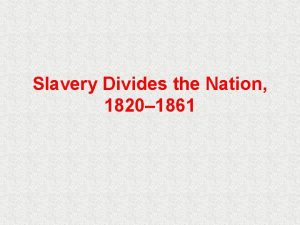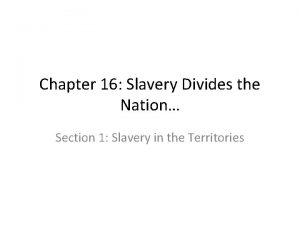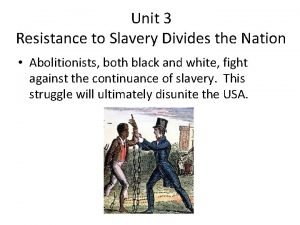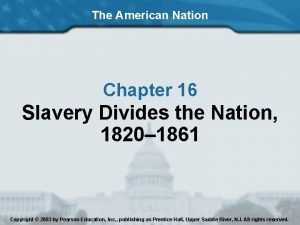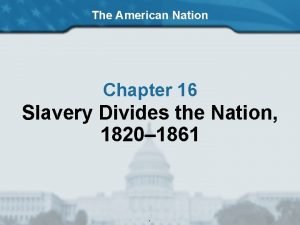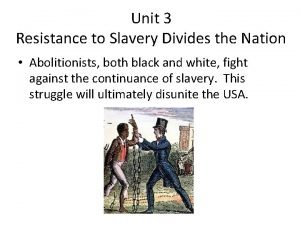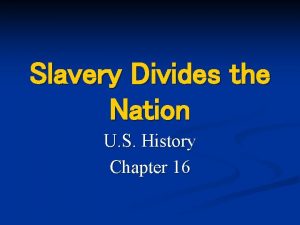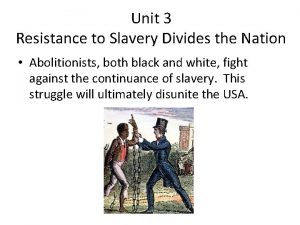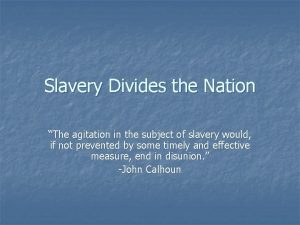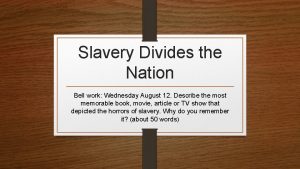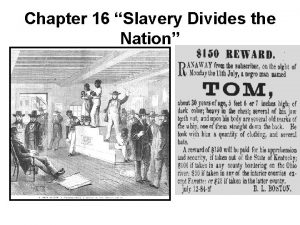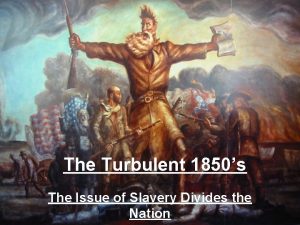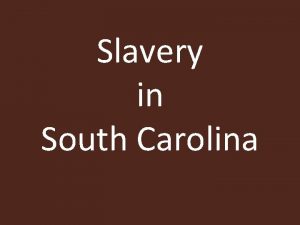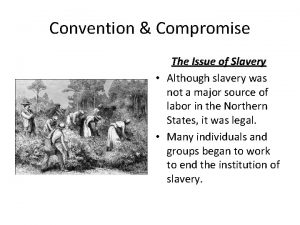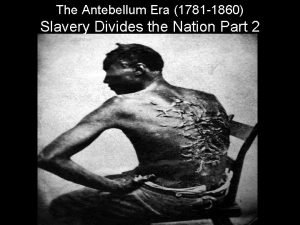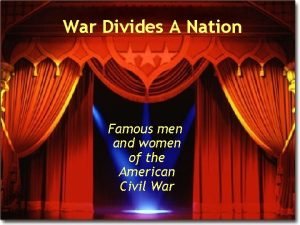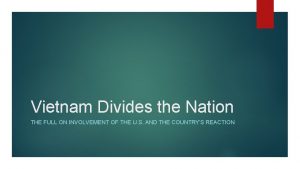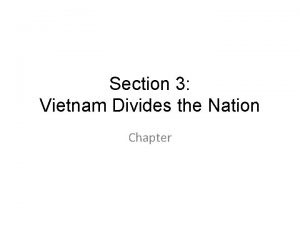Slavery Divides the Nation Slavery as an Issue
































- Slides: 32

Slavery Divides the Nation

Slavery as an Issue in the U. S. Ø Primarily an economic issue l l l Cash crops (sugar, tobacco, and cotton) South agriculturally based economy, dependent on slavery North industrial • Profit from slavery, but not a necessity • Northern industry fueled the need for slavery in the South Ø Constitutional issue l Slavery included in the Constitution • Important to win southern support at Constitutional convention • 3/5’s Compromise • Commerce and Slave Trade Compromise

Missouri Compromise Congress was even split between slave and free states (11 each) Ø Missouri wanted to be admitted as a slave state, would upset balance in congress Ø Henry Clay proposed a compromise Ø l l l Ø Missouri admitted a slave state Maine admitted as a free state Slavery outlawed in new territories north of 36 degrees 30 minutes latitude Temporary solution to a growing problem

Missouri Compromise 0 f 1820

Nullification Crisis Protective Tariff of 1816 increased in 1824 and 1828 Ø Southerners declared the tariff to be the “Tariff of Abomination” Ø Southerners felt they were forced to purchase higher priced goods made in the North. Ø Nullification Theory – proposed by John C. Calhoun (vice president), it said a state could nullify an unjust federal law. Ø

Nullification Crisis Con’t Ø 1832 new tariff passed Ø South Carolina declares it unconstitutional and null and void and threatens to secede if any attempt to collect the tax is made. Ø Compromise Tariff of 1833 – proposed by Henry Clay, it said that the tariff would be reduced over a 10 year period. Ø South Carolina agreed

Mexican War Ø Ø Texas becomes a state in 1845 Disputed border between U. S. and Mexico l Ø James K. Polk elected President 1845 l l l Ø Southerner, proslavery Believes in Manifest Destiny Wants California from Mexico, but they refuse to sell Sends Zachary Taylor and U. S. troops to the Rio Grande, battle occurs between the Mexican and U. S. troops l Ø Nueces v. the Rio Grande Several U. S. Soldiers are killed Polk demands war with Mexico as a result l l “American blood has been shed on American soil” Lincoln’s “Spot Resolution” protesting the war

Mexican War con’t United States clobbers Mexico Ø Mexican cession Ø l Ø Territory gained from Mexico after the war (California, Nevada, Colorado, New Mexico, and Arizona) Gadsden Purchase l U. S. purchases southern Arizona and New Mexico from Mexico for a railroad Mexican War a training ground for leaders of the Civil War Ø Slavery becomes a major issue in the territories acquired from Mexico Ø l Should it be allowed?

Wilmot Proviso Ø Ø Ø Ø Raises the issue of slavery in the territories again Plan proposed by David Wilmot to outlaw slavery in the territories acquired from the Mexican War. Antislavery supporters argued that no new slave states should be added in accordance with the wishes of the Founding Fathers (Northwest Ordinance) Southerners argued that western land should be open to slavery because otherwise it would restrict property rights Moderates argued extension of 36 -30 line into western territories Others suggested popular sovereignty for the area Passes the House of Reps, but does not pass in the Senate therefore it does not become law Birth of “Free Soil” party

California Statehood 1849 California’s applies to become a state Ø California’s constitution outlawed slavery Ø Majority of the state was in the south and according to the Missouri Compromise would be open to slavery Ø Congress divided on the issue of California statehood Ø California admitted as a free state in 1850 Ø Upsets the balance in congress, slave states now a minority Ø

Compromise of 1850 Ø Proposed by Henry Clay in an attempt to avoid secession Ø California admitted as a free state Ø Allowed popular sovereignty in other territories received from Mexico Ø Sale of slaves banned in DC Ø Congress would pass stronger laws to help slaveholders capture runaway slaves

Slave and Free Territories Under the Compromise of 1850

Fugitive Slave Act Ø Ø Ø Fugitives could be held without a warrant The accused slave was not allowed to testify on his own behalf A statement of ownership was the only think needed to have a slave returned Federal commissioners were paid $10 for returning a slave and $5 if the slave was freed Anyone convicted of aiding runaway slaves was subject to a $1000 fine, imprisonment for 6 months or both

Abolitionists Ø Ø Ø Abolitionists believed slavery was immoral…. . Peculiar institution or it is odd, strange or weird to own another human being. Abolitionists argued slavery was immoral because it violated the ideals that this country was founded on. Biblical principals applied as well All men are created equal (DOI) If the U. S. was to succeed as a democratic society, slavery had to be abolished

William Lloyd Garrison Ø 1831, he began publishing an abolitionist newspaper called The Liberator. Ø Many people in both the North and the South hated Garrison and his opinions. Ø Published over 1800 issues over 35 years

Garrison on the issue of Slavery “On this subject, I do not wish to think, or speak, or write, with moderation. No! no! Tell a man whose house is on fire, to give a moderate alarm; tell him to moderately rescue his wife from the hand of the ravisher; tell the mother to gradually extricate her babe from the fire into which it has fallen; -- but urge me not to use moderation in a cause like the present. I am in earnest -- I will not equivocate -- I will not excuse -- I will not retreat a single inch -- AND I WILL BE HEARD”.

Frederick Douglass Ø Ø Ø Former slave and abolitionist who became a well known and influential speaker. Son of a white man and an African American woman Bought his own freedom for $600 1845 published his autobiography detailing life as a slave Also published an antislavery newspaper The North Star Helped organize the 54 th Massachusetts

Underground Railroad Ø A secret network who would aid fugitive slaves in their escape to the north or Canada l l l Neither underground nor an actual railroad Provide shelter, food, and clothing Conductors – those people who aided the slaves Slaves journeyed at night, hid during the day “Follow the Drinking Gourd” song that gave slaves directions on their journey Journeys could last from several month to a year

Harriet Tubman Ø Ø Ø Most famous conductor of the Underground Railroad. “Moses of her people” Former slave herself Made 19 trips to the South to help slaves escape, helped more than 300 slaves escape, none ever captured Enemies offered $40, 000 for her capture

Underground Railroad

Uncle Tom’s Cabin Written in 1852 by Harriet Beecher Stowe Ø Fictional story about a slave named Uncle Tom, it discussed the moral issues of slavery Ø Supported by abolitionist and Northerners Ø Hated by Southerners Ø Became an instant bestseller selling more the 1 million copies by mid-1853 Ø

In the closing scenes of Harriet Beecher Stowe’s novel, Uncle Tom’s brutal master, Simon Legree, orders the $1200. 00 slave savagely beaten (to death) by two fellow slaves. Through tears and blood Tom exclaims, “No! no! my soul ain’t yours Mas’r! You haven’t bought it-----ye can’t buy it! It’s been bought and paid for by One that is able to keep it. No matter, no mater, you can’t harm me!” “I can’t” said Legree, with a sneer; “we’ll see----we’ll see! Here, Sambo, Quimbo, give this dog Reading/Tom’s Cabin

Kansas-Nebraska Act 1854 Stephen Douglas proposed a bill that would split the Nebraska Territory into two territories (Kansas and Nebraska) Ø Interested in building the transcontinental railroad through the territory Ø Nebraska would enter as a free state Ø Missouri Compromise would be repealed Ø Kansas was left to popular sovereignty on the issue of slavery Ø Passed and became law in 1854 Ø

“Bleeding Kansas” Ø Ø Ø March 1855 election of territorial legislature held Kansas split on slavery Proslavery supporters win election with the help of 5000 illegal votes from citizens, known as “boarder ruffians”, from Missouri Antislavery supporters refuse to accept the proslavery government and set up their own government “Sack of Lawrence” and “Pottawatomie Massacre” Attacks on the Senate floor l Ø Proslavery senator Preston Brooks savagely attacked and beat anti-slavery senator Charles Sumner with his cane Violence goes on for 3 years between pro and anti slavery forces in Kansas.

Brooks Beats Sumner

John Brown and Harpers Ferry Radical abolitionist Used violence to support abolitionist movement Ø Involved in massacre at Pottawattamie Creek in retaliation for murder of antislavery individuals during the sack of Lawrence (killed 5 proslavery men) Ø Plans and carries out a raid on arsenal at Harpers Ferry Virginia Ø Ø l l Ø Goal: slaves would rise up and rebel Massive failure, Brown arrested and hanged, sons are killed, Dangerfield Newby a free black man is killed Brown becomes martyr for the abolitionist cause l Claim this shows the government supports slavery

John Brown con’t • “I believe that the issue of slavery will never be solved unless through the shedding of blood. ” • Southerners were terrified that if John Brown almost got away with this, there must be others like him in the North who are willing to die to end slavery. • South’s outcome: To leave the U. S. and start their own country.

Dred Scott v. Sanford Ø Dred Scott, a slave sued for his freedom after his master died l Ø Said he lived in a free state (Illinois) therefore he was free Supreme Court Chief Justice Roger B. Taney ruled Scott was a slave therefore he had no right to sue in court l l l Violated the 5 th amendment and the protection of property Renders the Missouri Compromise unconstitutional Affirms the idea that slaves are property and nothing more Cast doubts on Constitutionality of Compromise of 1850 and Kansas. Nebraska Act Legitimized and legalized slavery in the U. S.

Lincoln Douglas Debates Ø 1858 midterm elections Ø Democrat Stephen Douglas (incumbent) challenged by Republican Abraham Lincoln for Illinois Senate seat in Congress. Ø 7 debates between the men l Douglas supports popular sovereignty • Tried to make Lincoln out to be an abolitionist and for racial equality l Lincoln supports the free-soil movement • Argues that he is not an abolitionist, he simply opposed extension of slavery into the territories

Lincoln Douglas Debate con’t Lincoln says “I have no purpose to introduce political and social equality between the white and the black races… notwithstanding all this, there is no reason in the world why the negro is not entitled to all the natural rights enumerated in the Declaration of Independence. ” Ø Lincoln also argues that the idea of popular sovereignty was not constitutional as a result of the Dred Scott decision. Ø Douglas will win the election but loose favor with Southerners Ø Lincoln becomes a significant political figure on the national stage for the Republicans and antislavery interests. Ø

Election of 1860 Ø Democrats split over nomination l l Northerners support Stephen Douglas Southerners will support John Breckenridge Southern moderates will support John C. Bell Ø Republicans nominate Abraham Lincoln Ø Lincoln wins the election with 180 electoral votes as a result of southern split Ø l Ø Does not appear on ballots in some Southern states Election of Lincoln pushes South Carolina to secede. l Federal power vs. states rights

The Process of Secession
 Slavery divides the nation
Slavery divides the nation Slavery meaning
Slavery meaning Slavery divides the nation
Slavery divides the nation Nation state vs nation
Nation state vs nation State vs nation
State vs nation Nation state vs nation
Nation state vs nation Dr mujahid nazal
Dr mujahid nazal Benefit segmentation
Benefit segmentation The equator divides the earth into
The equator divides the earth into Teamwork divides the task and doubles the success
Teamwork divides the task and doubles the success Software divided into
Software divided into Planes of the body
Planes of the body Continental divides
Continental divides A divides b
A divides b Teamwork divides the task and multiplies the success
Teamwork divides the task and multiplies the success Which letter represents the rhine river?
Which letter represents the rhine river? Lady body parts name
Lady body parts name The nfl targets several different market segments
The nfl targets several different market segments Chapter 14 anatomy and physiology
Chapter 14 anatomy and physiology Olecranal region
Olecranal region Body cell
Body cell 3 planes of the body
3 planes of the body The point that divides a segment into two
The point that divides a segment into two Pteris sp
Pteris sp To clarify any discrepancies in the plans use a
To clarify any discrepancies in the plans use a 285 ad
285 ad Categories of multimedia systems
Categories of multimedia systems Planes of the body
Planes of the body Teamwork divides the task and multiplies the success
Teamwork divides the task and multiplies the success What is the purpose of mitosis?
What is the purpose of mitosis? Centroid divides the median in the ratio
Centroid divides the median in the ratio What divides the nasal cavity
What divides the nasal cavity A strip of land that divides the desert from wetter areas
A strip of land that divides the desert from wetter areas

